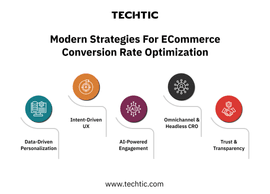The Ultimate Guide to eCommerce Conversion Rate Optimization in 2025
Sector: Digital Commerce
Author: Nisarg Mehta
Date Published: 09/29/2025

Contents
Boosting sales online isn’t some mystical art, it’s mostly about figuring out what makes real people tick, especially in an age where every screen is crowded by competitors jostling to be noticed. Other than, 2.1% is the average eCommerce conversion rate, if the last few years taught the industry anything, it’s that most advice for online stores, like “add a brighter button” or “test new headlines”, has become tired and overused. In 2025, online shoppers have grown wise to these tricks, so simply tweaking colors or tossing around discount pop-ups won’t win anyone’s loyalty.
This guide is all about cutting through the usual clutter. Instead of just rattling off another long checklist of “CRO best practices,” we want to shake things up. It’s time to challenge the old habits and highlight what actually moves the needle with today’s shoppers.
Rethinking Conversion Rate Optimization: Beyond Traditional Tactics
We’ve seen so many eCommerce teams get stuck in this cycle, endlessly tweaking button colors or swapping out headlines, all hoping for that magic sales spike. But honestly? That’s like slapping fresh paint on a house with a shaky foundation.
Cutting through the chaos means ditching generic one-size-fits-all advice. Shoppers today? Sharp as ever. They spot manipulative pop-ups and empty promises, then ignore them. So what grabs them? Trust, relevance, and feeling genuinely understood. Personalization isn’t a luxury now; it’s table stakes.
But it’s not about blasting out “Hey, [First Name]!” emails; it’s about weaving smart, responsive touchpoints throughout every interaction, from browsing to checkout.
Conversion rate optimization now demands an honest look at what actually nudges people toward a purchase. That means exploring fresh methods: blending behavioral data, tapping into zero-party insights customers share willingly, and relentlessly refining the journey for real users, not just based on theory. If old-school CRO feels stale, that’s because it is. This is an era for bold experiments and customer-first strategies, not recycled tips from ten-year-old blog posts.
Modern Strategies for eCommerce Conversion Rate Optimization
Let’s take you through the next-gen of eCommerce CRO:

1. Data-Driven Personalization (That Doesn’t Feel Creepy)
Picture walking into your favorite store. The clerk doesn’t just offer your usual shirt color but remembers your favorite brands, and those fabrics you can’t wear. That level of attention online retailers are chasing in 2025, but it only works if real and respectful. Get it wrong, and it backfires big time.
Generic “recommended for you” offers? Yeah, they don’t cut it anymore. Real personalization tunes into what customers do, say, and want, while respecting their privacy. Which, between us, is more fragile than ever. Invade that space? Big no-no.
Actionable tips for data-driven personalization:
- Encourage Genuine Logins: Not just discounts, but real value: saved carts that actually stick around, smooth order tracking, hassle-free returns. These small wins build trust and open doors for authentic personalization.
- Segment Thoughtfully: Don’t lump folks into broad groups. Think “eco-conscious regulars” or “impulse buyers”. Use browsing habits, purchase history, feedback to tailor product suggestions and homepage banners accordingly.
- Integrate User-Generated Content: Customer voices? Can’t stress it enough. Real reviews and photos add trust no algorithm can mimic.
- Customize Every Touchpoint: Personalization isn’t just your website. Emails, customer support, even what returning visitors see are crucial. A quick heads-up when a favorite item’s back, or homepage greetings for familiar faces, work wonders.
- Respect Privacy, Always: Use first-party data wisely. Be upfront about it. Let customers control their info. Make it known their data powers smarter recs, not relentless marketing.
- Test and Refine: Personalization isn’t “set and forget.” Test, listen, pivot. Brands that master this dance? They’re the ones customers remember.
2. Intent-Driven UX: Mapping and Optimizing High-Value User Journeys
We’ve found that intent-driven UX starts with really getting what users want at each step, and then designing pages that help them get there without fuss. The old “one path fits all” approach? That’s toast. Instead, the journey shifts dynamically depending on what the visitor’s after. For example, someone landing from a search like “best basketball shoes under $200” shouldn’t have to hunt for comparisons or prices, it should be front and center, clear as day.
Here’s what works for us when mapping those high-value user journeys:
- Map Real Buyer Intent: Use your analytics tools to see what folks are searching for and how they behave. Build tailored journeys for key intents, think “comparison,” “quick buy,” or “research.” The site paths should fit real behaviors, not just what you assume.
- Simplify Navigation Based on Behavior: Menus and filters should reflect what users actually look for. Make breadcrumbs and search bars ever-present so nobody feels lost. And don’t be shy about tweaking navigation as heatmaps and user sessions reveal new patterns.
- Speed Up Critical Pages: Pages where buying decisions happen, product pages, carts, checkout, need to load lightning fast and keep distractions invisible. The faster and cleaner, the less chance people bounce or freeze from decision overload.
- Use Contextual CTAs: Your calls-to-action should fit where visitors are in their journey. Someone ready to buy? Make that “Buy Now” button big, bright, and irresistible. Just browsing? Show “Learn More” or “Save for Later” as friendly nudges.
- Adopt Mobile-First Design: Most micro-moments happen on mobile, so design for thumb-friendly tap zones, scrollable content, and clear clickable areas. Ensure checkout is smooth and mobile optimized to capture high-intent buyers on smaller screens.
3. Intelligent On-Site Engagement Powered by AI
Okay, let’s just admit it: most of us used to worry that bots would annoy shoppers. Turns out, if you get timing and tone right, the little things, like a bot that notices someone hesitating on a product page and casually says, “Hey, did you see our comparison chart?”, that’s gold. Same goes for that bot popping up at checkout. We’ve watched it help a customer decide between two shoes, or just answer some question about delivery speed and suddenly, poof, the cart isn’t abandoned. Small stuff? Maybe. But those tiny nudges pile up real quick into real sales.
Actionable tips for AI-powered on-site engagement:
- Define Clear Objectives: What’s the bot actually for? If we don’t know, the results are random. Reducing abandoned carts. Upselling. Direct answers to “Will this fit me?” We’ve set goals, missed a few, hit more after a few tweaks.
- Implement Where It Matters Most: Where’s it needed most? We stick bots where stakes are high, checkout, product pages. Sometimes even social DMs. We’ve put them on random pages exactly once, results: meh.
- Keep Conversations Simple and Purposeful: How does it talk? Keep it brief. Half the team hates bots that ramble or offer every option under the sun. The other half just wants quick help. So, we build flows that move people along, fast.
- Integrate with Your Systems: Does it know enough? Sometimes our bots didn’t pull live inventory and gave old prices. Cue disappointment. We fixed it: now our bots talk to CRM, order data, so info’s always current.
- Plan for Smooth Human Handoffs: Bots freeze on the weirdest questions. If it sounds complicated (returns from overseas? Custom sizing?), we send folks to a real person. Last thing we want is a frustrated shopper ghosting us.
- Focus on Continuous Improvement: We tweak bots very frequently. Not kidding. We check transcripts, grumble at vague answers, patch up the logic, and ask customers what was weird or clunky. Improvement never stops.
- Prioritize Accessibility: Accessibility? We fell short once. The new site design didn’t work with screen readers. Our client called us at midnight, we fixed it. Clear text, easy navigation, always for everyone.
4. Conversion Optimization for Omnichannel and Headless Commerce
Let’s be honest, omnichannel success isn’t about tallying traffic stats from Instagram or the website in isolation. It’s about seeing your customers as whole people, not just clicks scattered across platforms. That means stitching together their behavior from every single touchpoint into one smooth story. When this happens right, personalization follows a shopper from their casual Instagram scroll right through to the checkout cart, without making them start over or repeat themselves (because honestly, who wants to do that?).
Headless commerce? Now that’s a game changer. It splits backend from frontend so brands can customize experiences with lightning-fast precision. Dynamic content, real-time updates, checkout flows that shape-shift based on context, whether you’re browsing on an app or barking commands to your voice assistant, it all fits perfectly. The payoff? Higher conversions thanks to user journeys designed for each channel, not just cookie-cutter web pages.
5. Trust and Transparency as Conversion Catalysts
Customers today? They’re sharp. They want truthful, upfront communication about what they’re buying, who they’re buying it from, and what happens after they click “Buy.” Being clear about shipping timelines, return policies, data use, and where your products come from can be the difference between cart completion or a fast exit.
Actionable tips for building trust and transparency:
- Display Real Customer Reviews and Ratings: Don’t just slap on star icons. Feature verified, unfiltered testimonials right where shoppers can see them, product pages, the homepage, everywhere. Nothing beats authentic social proof for building trust.
- Tell Your Brand Story: Use your “About Us” page to get real. Share your mission, values, even the bumps in your journey. Personal stories connect on a human level.
- Use Transparent Product Information: Provide detailed descriptions, accurate sizing guides, and clear visual merchandising to set correct expectations and reduce returns.
- Highlight Certifications or Awards: Got a BBB rating, quality certification, or industry award? Show it proudly. These badges scream credibility and boost shopper confidence.
Conversion Optimization Metrics for 2025
You know, when we talk about measuring success, it’s tempting to zero in on one key number, the conversion rate. And yeah, it’s important. It tells you what slice of your visitors actually buy something. But here’s the catch: it’s only one piece of a bigger picture in 2025.
A “good” conversion rate? Usually between 2% and 5%, depending on what you sell. Beauty and fashion folks tend to hit above 3%, whereas electronics juggle longer decisions and pricier carts, so their rates might dip a little lower.
But don’t sleep on these other crucial signals:
- Micro-conversions, for starters. These are like little breadcrumbs, newsletter signups, eyeballing product videos, adding to wishlists, they tell us where people are in their decision journey.
- Customer lifetime value. Or CLTV. That’s not just a fancy acronym. It’s knowing how valuable a customer is over time, not just a one-off sale. Smart CRO teams focus on this because returning customers are gold.
- Cart abandonment rates, high ones shout out friction spots or shopper hesitation. Tracking cart drops and the “why” behind them guides your most impactful fixes.
- Bounce rates and exit pages, knowing exactly where people bail helps pinpoint UX issues that scare visitors off.
- Attribution modeling’s a beast, yes. But necessary. You want to properly credit everything, social posts, search traffic, ads, if you want to see where the real ROI lies.
Tools? Oh, plenty. Google Analytics, Hotjar, other CRO platforms, they’re the brains behind your insights. Together, these metrics light the path toward smarter optimization.
Choosing the Right Service Provider for Conversion Rate Optimization
Finding the right CRO service is the kind of stuff that can make or break your store’s growth. Look for folks who know your industry inside out and think data-first. None of that surface-level fluff, please. The best will mix tech chops, UX savvy, and an intuitive grasp of customer behavior to cook up solutions that fit your biz like a glove.
For example, Techtic’s eCommerce maintenance and support services combine expert technical support with CRO strategies that build scalable conversion engines, ensuring continuous improvement and growth. Deep behavioral analysis, A/B tests, and real-time tracking, we keep things sharp and nimble.
Transparency and communication are key, choose a provider who shares their analysis, testing results, and strategic recommendations clearly and regularly. To help you make an informed decision, see Techtic’s detailed list of questions to ask when hiring an eCommerce CRO agency.
Avoid vendors promising quick fixes or generic solutions; effective CRO is an ongoing process requiring continuous experimentation and refinement. Learn more about how the right managed support team can improve store conversion rates and drive sustainable growth.
Finally, ensure your CRO partner integrates well with your existing tech stack for seamless deployment and tracking.
FAQs
Q: What is eCommerce Conversion Rate Optimization (CRO) and why is it important?
eCommerce CRO is the process of improving your online store to convert more visitors into paying customers. it goes beyond simple tweaks like button colors or pop-ups. Modern CRO focuses on personalization, intent-driven UX, AI-powered engagement, omnichannel experiences, and trust-building. Optimized CRO increases sales, reduces bounce rates, and improves customer lifetime value (CLTV).
Q: What are the modern strategies for improving eCommerce conversion rates?
Key strategies include:
- Data-driven personalization: Offering recommendations based on real user behavior and preferences while respecting privacy.
- Intent-driven UX: Mapping high-value user journeys and designing pages for quick decision-making.
- AI-powered engagement: Using intelligent chatbots and assistants to guide customers at critical touchpoints.
- Omnichannel and headless commerce: Providing seamless experiences across web, mobile, and app channels.
- Trust and transparency: Clear product info, authentic reviews, and reliable policies to increase shopper confidence.
Q: How can AI improve eCommerce conversion rates?
AI can help optimize conversions by:
- Predicting customer behavior to deliver personalized recommendations.
- Engaging users proactively via chatbots to reduce cart abandonment.
- Automating dynamic pricing, inventory management, and promotional campaigns.
- Analyzing behavioral data to continuously refine the user journey.
Brands using AI in 2025 see faster checkout completion, increased retention, and improved CLTV.
Q: How do I choose the right CRO service provider for my eCommerce store?
Look for agencies that:
- Understand your industry and customers deeply.
- Use data-driven strategies and continuously test for improvements.
- Communicate transparently with clear insights and reports.
- Integrate seamlessly with your tech stack.
- Avoid providers promising quick fixes; effective CRO is a long-term, iterative process.
Q: How does mobile optimization affect eCommerce conversions?
With over half of online shoppers using mobile devices in 2025, mobile optimization is critical for eCommerce success. Fast-loading pages, responsive layouts, and easy-to-tap buttons reduce friction and keep users engaged. A smooth mobile checkout experience lowers cart abandonment and builds trust with customers. The outcome: higher conversion rates, increased sales, and a stronger mobile shopping experience.



